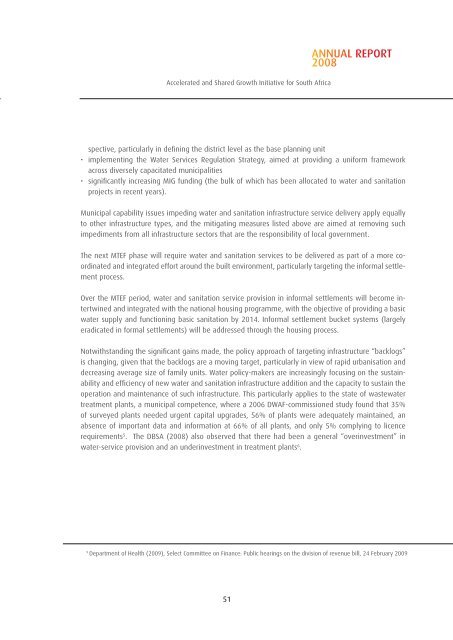(AsgiSA) Annual Report 2008 - South African Government Information
(AsgiSA) Annual Report 2008 - South African Government Information
(AsgiSA) Annual Report 2008 - South African Government Information
Create successful ePaper yourself
Turn your PDF publications into a flip-book with our unique Google optimized e-Paper software.
Accelerated and Shared Growth Initiative for <strong>South</strong> Africa<br />
ANNUAL REPORT<br />
<strong>2008</strong><br />
spective, particularly in defining the district level as the base planning unit<br />
• implementing the Water Services Regulation Strategy, aimed at providing a uniform framework<br />
across diversely capacitated municipalities<br />
• significantly increasing MIG funding (the bulk of which has been allocated to water and sanitation<br />
projects in recent years).<br />
Municipal capability issues impeding water and sanitation infrastructure service delivery apply equally<br />
to other infrastructure types, and the mitigating measures listed above are aimed at removing such<br />
impediments from all infrastructure sectors that are the responsibility of local government.<br />
The next MTEF phase will require water and sanitation services to be delivered as part of a more coordinated<br />
and integrated effort around the built environment, particularly targeting the informal settlement<br />
process.<br />
Over the MTEF period, water and sanitation service provision in informal settlements will become intertwined<br />
and integrated with the national housing programme, with the objective of providing a basic<br />
water supply and functioning basic sanitation by 2014. Informal settlement bucket systems (largely<br />
eradicated in formal settlements) will be addressed through the housing process.<br />
Notwithstanding the significant gains made, the policy approach of targeting infrastructure “backlogs”<br />
is changing, given that the backlogs are a moving target, particularly in view of rapid urbanisation and<br />
decreasing average size of family units. Water policy-makers are increasingly focusing on the sustainability<br />
and efficiency of new water and sanitation infrastructure addition and the capacity to sustain the<br />
operation and maintenance of such infrastructure. This particularly applies to the state of wastewater<br />
treatment plants, a municipal competence, where a 2006 DWAF-commissioned study found that 35%<br />
of surveyed plants needed urgent capital upgrades, 56% of plants were adequately maintained, an<br />
absence of important data and information at 66% of all plants, and only 5% complying to licence<br />
requirements 5 . The DBSA (<strong>2008</strong>) also observed that there had been a general “overinvestment” in<br />
water-service provision and an underinvestment in treatment plants 6 .<br />
9<br />
Department of Health (2009), Select Committee on Finance: Public hearings on the division of revenue bill, 24 February 2009<br />
51

















